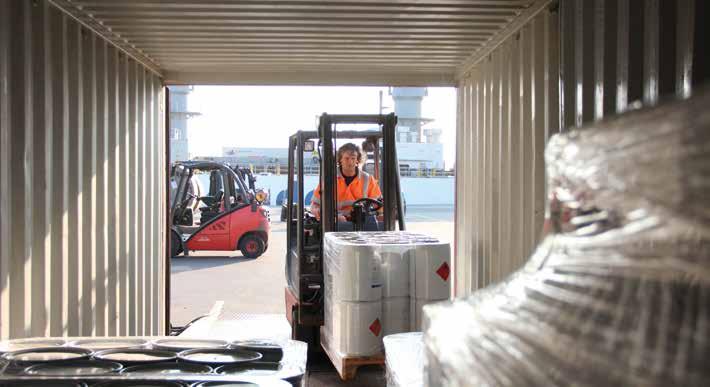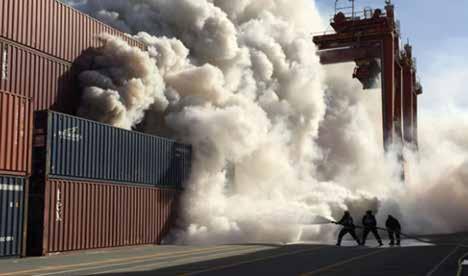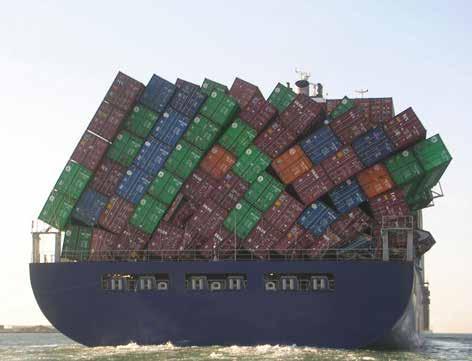
13 minute read
TT Club calls for Cargo Integrity
LET’S BE HONEST
CONTAINERS • ISSUES THAT UNDERMINE SAFETY IN THE INTERMODAL SUPPLY CHAIN ARE AN INCREASING THREAT IN THESE DAYS OF MEGA-CONTAINERSHIPS. ACTION IS NEEDED
YANTIAN EXPRESS, APL Vancouver, Grande America, ER Kobe – four ships with one thing in common: each of them suffered a fire in a container while underway during the first three months of 2019. While it is not yet known in each case what caused these fires, and there are scenarios in which they may have been caused by factors such as overexuberant fumigation or the off-gassing of solvents or adhesives used in the manufacture of the goods within the containers, it is most likely that the fires started in containers with undeclared or mis-declared dangerous goods.
According to the TT Club, there is on average one major containership fire every 60 days; it also says that, across the intermodal spectrum as a whole, two-thirds of incidents related to cargo damage can be attributed to poor practice in the overall packing process; that is not just in securing but also in cargo identification, declaration, documentation and effective data transfer. These incidents are calculated to cost insurers in excess of $500m a year – and with the increasing size of containerships there is the fear that a single major event could cost the sector as much as $2bn.
Peregrine Storrs-Fox, risk management director at the TT Club, is one of those spearheading the new Cargo Integrity initiative. “We are endeavouring to focus all direct and indirect stakeholders on recognising and doing the right thing,” he says. “One particularly critical aspect of this is the correct declaration and handling of dangerous goods.”
TOO GOOD TO FAIL But it is not simply a matter of getting the basics right when handling dangerous goods – a holistic view is needed if industry is to reconcile the threats to life, property and the environment with the characteristics that make the container shipping business such a successful motor of world trade.
The physical integrity of the shipping container is the primary reason why it has such a dominant position in transporting general cargo around the world. What many called a revolution in global trade was initiated in the late 1950s and ‘60s when the introduction of metal containers, later standardised to twenty and forty feet in length, challenged the traditional ‘break bulk’ methods of cargo handling.
At once these relatively simple metal boxes improved security, speeded up port operations and ship turnaround times and, crucially, allowed the integrity of the load to be maintained intact from the shipper’s premises to those of the consignee, utilising modes of land transport as well as ships.
“Some sixty years on we face a lack of a quite different sort of integrity – the integrity of knowledge, information flow and data transfer, as well as the correct care for the cargo inside the container,” Storrs-Fox says. “The speed of cargo transport around the world and the complexity of supply chains,
both in terms of geographical diversity and the myriad ‘hands’ through which cargo may pass, is the container’s achievement but also a cause of considerable risk.”
DEFINING THE PROBLEM In the maritime segment of global supply chains, sources suggest that container fires may occur on a weekly basis and statistics indicate there is a major container cargo fire at sea roughly every 60 days. There have been several well publicised shipboard explosions and fires involving laden containers over the past few years. The tragedies of MSC Flaminia in July 2012 and Maersk Honam in March 2018 both sadly cost multiple lives, likely resulting in insured losses in the hundreds of millions of dollars and overall economic loss to the industry of multiples of the insured element.
As the size of containerships increases, so does the potential risk and consequence of a large explosion or fire incident. Despite regulatory and technical advances, there is little doubt that the capability to respond to a cargo-related fire at sea has not progressed in proportion to ship capacities and the variety of commodities being carried.
This burden of loss has been tolerated in part because fragmentation in each stakeholder segment means that most entities bear a portion of their own losses within risk appetite, but also because the global intermodal supply chain has developed complex practices, some of which detract from safety and certainty of outcome.
THE DANGEROUS ELEMENT All types of cargo can be mishandled. However, wrongly classified, declared or labelled dangerous goods are seen as the primary hazard. The representative body of cargo handling and container terminal operators, ICHCA International, has extrapolated statistical evidence of the extent of the problem. It calculates that of an estimated 60 million packed containers moved around the globe each year, 10 per cent are declared to contain dangerous goods; that is 6 million containers that need varying degrees of special handling, positioning in terminals and stowage onboard ships.
Information from government inspections, which are biased towards declared dangerous goods shipments, suggests that more than 20 per cent are poorly packed or incorrectly identified in some way. That ratio converts to 1.3 million potentially unstable declared dangerous goods loads per year.
It is more challenging to estimate the amount of dangerous goods cargo that goes undeclared. An initiative by HapagLloyd and more lately by IBM has seen the development of a detection system, Cargo Patrol, which attempts to identify cargoes that may be undeclared dangerous goods at the time a shipper books the move with a shipping line, leading to more detailed investigation before acceptance.
From the ‘potential hits’ thrown up by the system it would seem that between 2 and 5 per cent transpire to be more than likely undeclared dangerous goods. Extrapolating these findings across the total annual global container trade, it might be reasonable to estimate that there are some 150,000 ticking container time-bombs each year carrying potentially volatile misdeclared cargo.
SOME SOLUTIONS The Cargo Patrol initiative and the efforts of IBM to make it accessible to all lines is an example of a communal approach to improving safety surrounding the transport of containers both on land and at sea. This sort of cooperation among the shipping lines and others (including TT Club) began some seven years ago with the founding by five of the top liner operators of an organisation aiming to capture key incident data in order to provide an early warning of worrying trends, whether relating to cargoes that display dangerous characteristics or unsafe practices in the container supply chain. The Cargo Incident Notification System or CINS (www.cinsnet.com) now has a membership that includes 18 liner operators, representing more than 70 per cent of container slot capacity.
CINS facilitates the capture by liner operators of structured key causal information in connection with cargo and container related incidents. This information capture explicitly excludes any shipper data in order to preclude any anti-trust concerns.
The objective of the organisation is to highlight the risks posed by certain cargoes and/or packing failures in order to improve safety through the supply chain and specifically onboard ships. The aspiration is that all significant incidents caused by the cargo itself or the container equipment leading to injury or loss of life, environmental concerns, or damage to cargo and assets should be reported, together with investigation conclusions that identify causation. »
GETTING THE CONTAINER LOADED PROPERLY IS THE

SPREAD THE WORD The need for more transparency is not limited to shipping lines; many other actors in the supply chain, most notably the shippers and forwarders who are responsible for packing the containers and the crucial initial declarations of what they contain, as well as ports and terminals, must become more knowledgeable about safety procedures and more vigilant in minimising errors.
Procedures governing dangerous goods handling around the world, for instance, are complex. Each carrier has its own restrictions in relation to house policies, shipowner policies, ship constraints and restrictions applied at ports/terminals of loading, transit, transhipment and discharge. The complexity and lack of standardisation can be bewildering even to the most experienced shipping clerk or warehouse operative, and exacerbates the possibility for error or failure to update. It is also intensely inefficient and hugely burdensome.
In order to help clarify the situation, Exis Technologies, with the support of TT Club and its sister insurance mutual, the UK P&I Club, has developed a portal integrating information on such restrictions. The Hazcheck Restrictions Portal (http:// hazcheck.existec.com/hazcheck-systems/ hazcheck-restrictions) is designed to simplify the end-to-end management of DG booking processes, taking account of port, terminal carrier, ship and partner line restrictions.
Once more cooperation is urged; ports/ terminals and liner operators can upload their DG handling policies and restrictions into the portal free of charge, allowing their use by shippers, forwarders and others involved in the movement of such goods. REGULATION AND BEST PRACTICE There are two internationally recognised codes, produced by the International Maritime Organisation (IMO), that guide, instruct and govern the safe transport of cargoes in containers; the mandatory International Maritime Dangerous Goods (IMDG) Code and the Code of Practice for Packing of Cargo Transport Units (CTU Code).
Under the terms of the IMDG Code it is mandatory for all shore-based personnel involved in dangerous goods transport by sea to have training. While there are numerous national trade bodies providing appropriate and compliant dangerous goods courses, the challenge remains to reach those who currently slip through the net.
IMDG clarifies the population of shorebased personnel as all who are involved in the shipment of dangerous goods and mandates that they receive training “commensurate with their responsibilities” (before they undertake them). Clearly this definition encompasses a large group of people not immediately identified with the maritime industry, but connected by reason of initiating or packing an intermodal consignment.
Once more, the need to deliver the message of cargo integrity throughout the supply chain is clearly evidenced. For its part, TT Club has joined forces with UK P&I Club to update and revise the Book it right and pack it tight publication, which provides a thorough introduction and guidance on the provisions of the IMDG Code. This is freely available as a PDF at www.ttclub.com/fileadmin/uploads/ tt-club/Documents/UK-TT_BIRPIT_2018_ secured.pdf.
BUILDING TRUST However, apart from reiterating the need for training and awareness, TT Club emphasises that trust through the supply chain requires more. Due to the complexity of the international supply chain, the entity identified as the ‘consignor’ on the dangerous goods document may not have direct or


TOP: TT CLUB’S PEREGRINE STORRS-FOX IS
physical control over key elements of the end-to-end process, but needs to be aware that legal liability rests with the ‘consignor’ and ensure that arrangements are in place to be in compliance with these international and national regulations.
Not all ‘consignors’ will be conversant with such responsibilities, with the result that counterparties should take additional actions. Thus, there are three steps inherent in achieving compliance and assurance throughout the supply chain: 1. Ensure that your own relevant employees are competent; 2. Inform all your customers, contractors and suppliers of their obligations to train to an appropriate level of competence; and 3. Obtain documentary evidence that all relevant employees of your customers, contractors and suppliers are trained to an appropriate level of competence.
While training to achieve ‘competence’ – or the ability to do a job properly – is critical and required by law, it needs to be followed through. This means that the training records not only should be maintained but also be available. It is clear that the system has yet to work effectively.
KNOW YOUR PARTNERS The importance of carrying out due diligence was set out in relation to the CTU Code in the IMO Circular MSC.1/Circ.1531. Interestingly, that document envisages the checks being addressed to those who seek to select a “provider of CTU-related services”. In an age where looking counter-parties in the eye is rare, this provides a good model in both directions; it is as important for the ‘provider’ (forwarder, logistics operator or carrier) to ‘know your customer’ as for the customer to seek assurance in relation to the contractor.
Reality triggers should be applied to consider the risk of dangerous goods. A quick internet search can identify key characteristics of a shipper or consignor – and consignee. A chemical factory is more than likely to need to demonstrate compliance with the training requirement. Equally, recognise that a garden centre consignee may just as validly seek shipment of pesticides or fertilisers as tools and wheelbarrows.
The CTU Code is now a non-mandatory Code of Practice adopted by the IMO. While certain jurisdictions may or may not implement the code into national legislation, the entire freight industry must recognise that this detailed guidance may now be used in any litigation as a demonstration of good industry practice. The TT Club cannot stress enough that all parties need to become familiar with the contents and develop ways to implement and encourage compliance with the CTU Code.
Having repeatedly drawn attention to the consequences of inappropriate load distribution and badly secured cargo within CTUs (including shipping containers), including bodily injury, an increased level of training of those employed by shippers, consolidators, warehouses and depots to pack containers and other transport units is now essential. To help meet this need, TT Club commissioned Exis Technologies to develop e-learning training courses for the transport industry, resulting in the launch of CTUpack e-learning™ (www.ctupack.com).
OPEN THE BOX While the IMDG Code is mandatory and all IMO member states are required to incorporate its requirements in national law, enforcement is little known and inspections (on which evidence of transgression is reliant) are few and far between.
On analysing reports submitted to IMO in the past, TT Club has established that the number of member states reporting on their inspections, in comparison with those in membership of IMO, has always been less than 10 per cent and currently stands at about 2.5 per cent; on average only 4 or 5 of the 170 member states regularly report. Of the inspections that are carried out as many as 75 per cent are usually in the US.
This is a woefully low rate of inspection and next to useless in order to enforce the regulations, derive change requirements or provide evidence of frequent transgressors in terms of shippers and commodities.
TT Club, working with industry partners, will continue to put pressure on UN agencies, governments and the full range of stakeholders in the intermodal supply chain, recommending changes to improve safety, and identify practices and behaviours that can undermine certainty of outcome for trade in general and present increased risk for people, ships and the environment.
It is clear that the effectiveness of TT Club’s call for cargo integrity must take a broad approach, not relying on the power of regulation or the vigilance and discipline of carriers or port operators, but carrying the safety message far and wide, including engaging with entities involved in fiscal, health, security and anti-trust regulation, and embracing technical innovations that can assist in monitoring and condition reporting. Those involved in inspections, surveys and advice to the packing industry globally are thus key potential agents of the significant culture change that is required. HCB

This article is based in part on a contribution by the TT Club to the International Institute of Marine Surveying’s (IIMS) newsletter, The Report.










